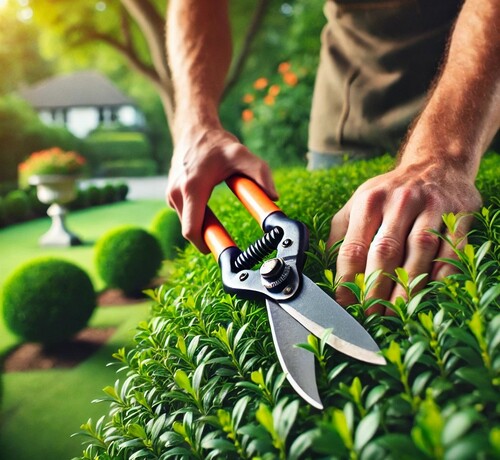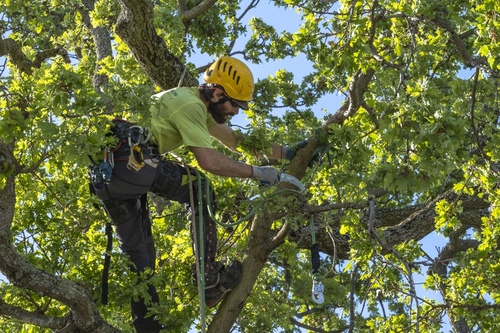Pruning vs. Shearing: What’s Best for Your Landscape?
Introduction
Maintaining a beautiful and healthy landscape requires understanding various plant care techniques. Two common methods of managing trees and shrubs are pruning and shearing. While these terms are often used interchangeably, they represent distinct approaches with different impacts on your plants. This guide will help you understand the differences between pruning and shearing, their side effects on plant health, and how to choose the right method for your landscape.
Understanding Pruning and Shearing
Before diving into the pros and cons of each technique, let’s clearly define pruning and shearing.
What is Pruning?
Pruning is a selective and precise method of removing specific branches or stems from a plant. This technique is used to:
- Promote healthy growth
- Improve plant structure
- Control size and shape
- Remove dead, diseased, or damaged parts
- Enhance flowering or fruit production
Pruning is typically done with hand pruners, loppers, or pruning saws depending on the size of the branches being removed.
What is Shearing?
Shearing , in contrast, is a less selective method that involves:
- Cutting back the outermost growth of shrubs or hedges
- Creating a uniform surface or specific shape
- Using powered or manual hedge shears
- Removing foliage without regard to branch structure
Shearing is often used for formal hedges or topiary designs but can have drawbacks for plant health if not done properly.
The Impact of Pruning vs. Shearing on Plant Health

A Landscaper Shearing a Bush with Precision Using Professional Hedge Shears
Understanding how these techniques affect your plants is crucial for maintaining a thriving landscape.
Benefits of Proper Pruning
- Encourages healthy growth throughout the plant
- Improves air circulation and light penetration
- Allows for targeted removal of problematic branches
- Maintains the plant’s natural form
- Can extend the life of trees and shrubs
Potential Drawbacks of Shearing:
- Limits growth to the outer parts of the plant
- Can create dense outer growth that blocks light from reaching the interior
- May increase susceptibility to pests and diseases
- Often requires more frequent maintenance
- Can lead to long-term structural issues in some plants
When to Choose Pruning or Shearing
A Professional Arborist Pruning a Large Tree Branch with Precision Tree Care Techniques
Deciding between pruning and shearing depends on your landscape goals and the types of plants you’re working with.
Ideal Scenarios for Pruning
- Maintaining the health of ornamental trees
- Shaping fruit trees for better production
- Managing the size of individual shrubs
- Rejuvenating overgrown plants
Appropriate Uses for Shearing
- Creating formal hedges or topiaries
- Maintaining large barrier hedges
- Achieving specific geometric shapes in the landscape
Best Practices for Pruning and Shearing
To ensure the best results for your landscape, follow these guidelines:
Pruning Tips
- Use clean, sharp tools to make clean cuts
- Prune at the right time of year for each plant species
- Remove no more than 25 percent of live growth in a single season
- Cut back to a lateral branch or bud to promote healthy regrowth
Shearing Guidelines
- Shear only plants that respond well to this technique (e.g. boxwood, privet)
- Maintain a slight taper from bottom to top for sunlight penetration
- Shear during the growing season to encourage quick regrowth
- Combine with occasional selective pruning to maintain plant health
Alternatives to Frequent Shearing
For a lower-maintenance landscape , consider these alternatives to regular shearing:
- Choose plants that naturally grow to the desired size and shape
- Use dwarf varieties for hedges or borders
- Implement informal hedges that require less frequent trimming
- Incorporate mixed plantings instead of uniform hedges
When to Seek Professional Help

An Arborist in Safety Gear Trimming a Tree Branch with Professional Pruning Tools
While many homeowners can handle basic pruning and shearing, some situations call for expert assistance :
- Large or mature trees that require specialized equipment
- Plants with complex pruning needs (e.g., fruit trees, roses)
- Rejuvenation of severely overgrown shrubs
- Design and maintenance of formal gardens or topiaries
For those of you in the San Francisco Bay Area, Arborist Now offers professional tree care services. Our certified arborists can assess your landscape, recommend basic care practices, and perform expert pruning to ensure the health and beauty of your trees.
Conclusion
Understanding the differences between pruning and shearing is crucial for maintaining a healthy, attractive landscape. While pruning offers many benefits for plant health and structure, shearing can be appropriate for specific landscape styles. By choosing the right technique for each plant and situation, you can create a beautiful outdoor space that thrives year after year.
Remember, when in doubt, contact Arborist Now today to determine the best approach for your unique landscape needs. With proper care and maintenance, your trees and shrubs can provide beauty, shade, and value to your property for generations to come.
Originally posted on February 27, 2020.



